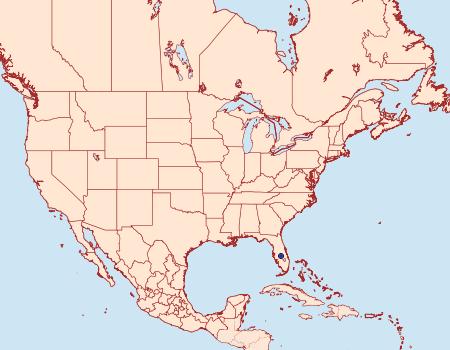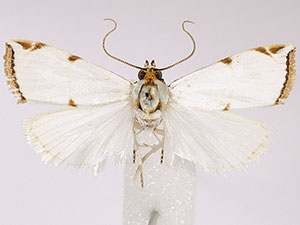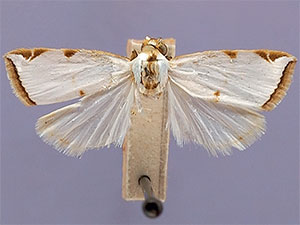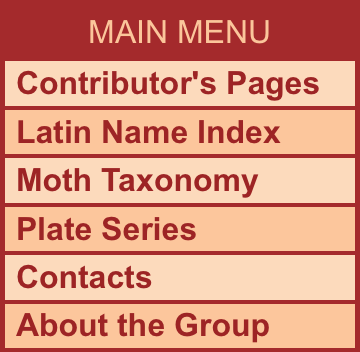Crambidae
80a1453.2 –
5463.2 Argyria centrifugens
Dyar, 1914
|
|
|
| Photographs are the copyrighted property of each photographer listed. Contact individual photographers for permission to use for any purpose. |

Large Map & Chart
Report Errors
About Maps
|
| Distribution: |
USA: FL. |
Description/
Field Marks: |
Labial palpi brown dorsally; a subapical coastal dash is followed by a subapical triangle. Wingspan: 16-19 mm. (Landry et al. 2023). |
| Similar Species: |
- 80a1453.1 Argyria gonogramma: has labial palpi white dorsally; the subapical coastal dash is not followed by a subapical triangle. Wingspan: 10.5-13.5 mm. (Landry et al. 2023).
- 80a1453 Argyria lacteella: has labial palpi white dorsally; a subapical coastal dash is followed by a subapical triangle. Wingspan: 9.5-14 mm. (Landry et al. 2023).
- Pinned specimens of related species. (Hint: select View by Region on the related species page.)
|
| Synonymy: |
centrifugens Dyar, 1914 (Argyria) STRAY - MONA 1983: [NEW]; TL: Panama, Canal Zone, Paraiso. |
| Taxonomic Notes: |
Argyria centrifugens Dyar, 1914 is now recognized within the North American fauna, Florida, in Landry et al. (2023). |
|
| References (Caution: DNA barcoding at BOLD provides evidence of relatedness, not proof of identification; some BOLD specimens shown may not be sequenced.) |
- Barcode of Life (BOLD) - Caution: Identifications often erroneous; DNA barcode provides evidence of relatedness, not proof of identification; many specimens not sequenced.
- Barcode of Life (BOLD) - BIN: BOLD:AAA0339 - Caution: DNA barcode provides evidence of relatedness, not proof of identification.
- Dyar, H.G., 1914. Report on the Lepidoptera of the Smithsonian biological survey of the Panama Canal Zone. Proceedings of the United States National Museum, 47 (2050): 318.
- Landry, B., J. Bilat, J. Hayden, M.A. Solis, D.C. Lees, N. Alvarez, T. Léger & J. Gauthier, 2023. The identity of Argyria lacteella (Fabricius, 1794) (Lepidoptera, Pyraloidea, Crambinae), synonyms, and related species revealed by morphology and DNA capture in type specimens. ZooKeys, 1146: 1-42.
- Species Page at BugGuide.Net
- Species Page at iNaturalist
|

(Colombia) LG – © Bernard Landry

 - holotype - LG – (c) U. S. National Museum
|






 - holotype -
- holotype -